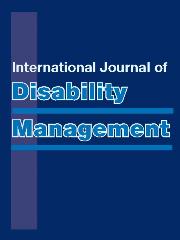Article contents
Canadian Employee Perspectives on Disability Management
Published online by Cambridge University Press: 18 September 2017
Abstract
A Canadian sample was collected as an aspect of a large international project, with representation from Australia, Canada, China, and Switzerland. In each country, interview and survey data were collected using team-created research tools. Canadian survey data on disability management (DM) perceptions were collected from 218 employees in both public and private organisations. Our Canadian employee sample reported perceived influence of disability prevention on job satisfaction, physical health, mental health, and morale for both themselves and their coworkers. Return to work programs were seen as valuable for job satisfaction of both the employee and coworkers, as well as the physical health of coworkers. Similarly, stay at work programs were seen as valuable for mental health and morale of coworkers. There was no relationship between perceived influence of DM interventions and reduction of sickness absence. The influence of DM was perceived as more positive for private and/or nonunionised workplaces. No gender differences were evident.
- Type
- Articles
- Information
- Copyright
- Copyright © The Author(s) 2017
References
- 3
- Cited by


